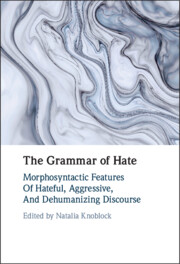
-
Select format
-
- Publisher:
- Cambridge University Press
- Publication date:
- June 2022
- July 2022
- ISBN:
- 9781108991841
- 9781108834131
- 9781108994347
- Dimensions:
- (229 x 152 mm)
- Weight & Pages:
- 0.6kg, 310 Pages
- Dimensions:
- (229 x 152 mm)
- Weight & Pages:
- 0.451kg, 310 Pages
You may already have access via personal or institutional login
Book description
Hate speech continues to be an issue of key social significance, yet while its lexical and discursive aspects have been widely studied, its grammatical traits have been hitherto overlooked. This book seeks to address this gap by bringing together a global team of scholars to explore the morphosyntactic features of hateful and aggressive discourse. Drawing on thirteen diverse cross-linguistic case studies, it reveals how hate is expressed in political discourse, slang, and social media, and towards a range of target groups relating to gender, sexual orientation, and ethnic identity. Based on ideas from functional and cognitive linguistics, each thematic part demonstrates how features such as morphology, word formation, pronoun use, and syntactic structures are manipulated for the purpose of expressing hostility and hate. An innovative approach to an age-old problem, this book is essential reading for researchers and students of hate speech and verbal aggression.
Reviews
‘We need this book. Grammar in all its guises is given short-shrift in studies of hateful, aggressive discourse, yet even a cursory glance at the contents of this book will show that its neglect is not merited. An accessible, interesting, diverse, illuminating read!’
Jonathan Culpeper - Professor of English Language and Linguistics, Lancaster University
‘This book offers a leap forward towards better understanding aggressive, hateful, and dehumanizing communication from a morphosyntactic perspective contextualized by its social interactions.’
Monica Cantero - Drew University
Contents
Metrics
Altmetric attention score
Full text views
Full text views help Loading metrics...
Loading metrics...
* Views captured on Cambridge Core between #date#. This data will be updated every 24 hours.
Usage data cannot currently be displayed.
Accessibility standard: Unknown
Why this information is here
This section outlines the accessibility features of this content - including support for screen readers, full keyboard navigation and high-contrast display options. This may not be relevant for you.
Accessibility Information
Accessibility compliance for the PDF of this book is currently unknown and may be updated in the future.


